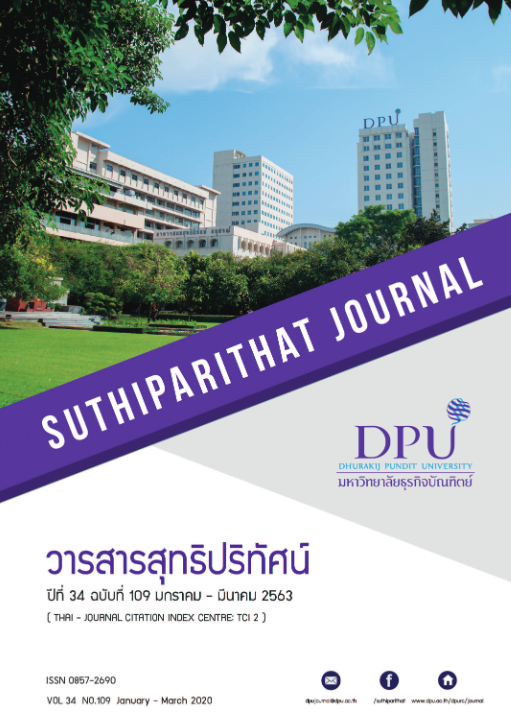การกำกับดูแลกิจการ ผลการดำเนินงานและมูลค่ากิจการตามราคาตลาดของบริษัทจดทะเบียนในตลาดหลักทรัพย์แห่งประเทศไทยในกลุ่ม MAI
คำสำคัญ:
การกำกับดูแลกิจการ, ผลการดำเนินงาน, มูลค่ากิจการตามราคาตลาดบทคัดย่อ
การวิจัยครั้งนี้มีวัตถุประสงค์เพื่อ 1) ศึกษาความสัมพันธ์ระหว่างการกำกับดูแลกิจการ (โครงสร้างผู้ถือหุ้น โครงสร้างกรรมการบริษัท ค่าตอบแทนกรรมการ ค่าธรรมเนียมสอบบัญชี) กับผลการดำเนินงานของบริษัทจดทะเบียนในตลาดหลักทรัพย์แห่งประเทศไทยในกลุ่ม MAI 2) ศึกษาความสัมพันธ์ระหว่างผลการดำเนินงานกับมูลค่ากิจการตามราคาตลาดของบริษัทจดทะเบียนในตลาดหลักทรัพย์แห่งประเทศไทยในกลุ่ม MAI 3) ศึกษาผลกระทบของการกำกับดูแลกิจการ (โครงสร้างผู้ถือหุ้น โครงสร้างกรรมการบริษัท ค่าตอบแทนกรรมการ ค่าธรรมเนียมสอบบัญชี) ที่มีต่อมูลค่ากิจการ ผ่านผลการดำเนินงานของบริษัทจดทะเบียนในตลาดหลักทรัพย์แห่งประเทศไทยในกลุ่ม MAI โดยใช้วิธีการวิจัยแบบเชิงปริมาณ กลุ่มตัวอย่าง ได้แก่ บริษัทจดทะเบียนในตลาดหลักทรัพย์แห่งประเทศไทยกลุ่ม MAI จำนวน 77 บริษัท วิเคราะห์ข้อมูลด้วยสถิติวิเคราะห์โมเดลสมการโครงสร้าง (Structural Equation Model: SEM) ผลการวิจัย พบว่า 1) ผลการพัฒนารูปแบบความสัมพันธ์เชิงสาเหตุของการกำกับดูแลกิจการ ประกอบด้วยองค์ประกอบ โครงสร้างผู้ถือหุ้น โครงสร้างกรรมการบริษัท ค่าตอบแทนกรรมการ ค่าธรรมเนียมสอบบัญชี เป็นไปตามรูปแบบความสัมพันธ์เชิงสาเหตุของผลการดำเนินงาน และมูลค่ากิจการตามราคาตลาด แบบจำลองสมการที่ผู้วิจัยพัฒนาขึ้นมีความเหมาะสมสอดคล้องกับข้อมูลเชิงประจักษ์ และ 2) การกำกับดูแลกิจการ โครงสร้างกรรมการบริษัท ค่าตอบแทนกรรมการ ค่าธรรมเนียมสอบบัญชี มีความสัมพันธ์กับผลการดำเนินงาน และส่งผลต่อมูลค่ากิจการตามราคาตลาดอย่างมีนัยสำคัญทางสถิติ
เอกสารอ้างอิง
สุภมาส อังศุโชติ. (2554). สถิติวิเคราะห์สำหรับวิจัยทางสังคมศาสตร์และพฤติกรรมศาสตร์ : เทคนิคการใช้โปรแกรม LISREL.
สุภมาส อังศุโชติ, สมถวิล วิจิตรวรรณา, และรัชนีกูล ภิญโญภานุวัฒน์ (พิมพ์ครั้งที่ 3 (ฉบับปรับปรุง)). กรุงเทพฯ: เจริญดีมั่นคงการพิมพ์.
Alsaeed, K. (2006). The association between firm-specific characteristics and disclosure: The case of Saudi Arabia. Managerial Auditing Journal, 21(5), 476-496.
Andreas, J.M., Rapp, M.S., & Wolff, M. (2012). Determinants of director compensation in two-tier systems: Evidence from German panel data. Review of Managerial Science, 6(1), 33-79.
Arora, A., & Sharma, C. (2016). Corporate governance and firm performance in developing countries: Evidence from India. Emerald Insight, Corporate Governance, 16(2), 420-436.
Bell, T. B., Doogar, R., & Solomon, I. (2008). Audit labor usage and fees under business risk auditing. Journal of Accounting Research, 46(4), 729-760.
Bellesta, J. P. S., & Meca, E. G. (2007). Ownership structure, discretionary accruals & the informativeness of earnings. Corporate governance: An International Review, 15(4), 677-691.
Brick, I. E., Palmon, O., & Wald, J. K. (2006). CEO compensation, director compensation, and firm performance: evidence of cronyism ?. Journal of Corporate Finance, 12(3), 403-423.
Corporate Governance Report of Thai Listed Companies (CGR). (2018). Thai Institute of Directors. (IOD).From https://www.thai-iod.com/en/publications-detail.asp?id=447.
Duong L., & Evans J. (2015). CFO compensation: Evidence from Australia. Pacific Basin Finance Journal, 35, 425-443.
Freedman, M., & Jaggi, B. (1983). Pollution disclosures, pollution performance and economic performance: Omega. The International Journal of Management Science, 10, 167-176.
Haniffa, R., & Hudaib, M. (2006). Corporate governance structure and performance of Malaysia Listed Companies. Journal of Business Finance & Accounting, 33(7-8), 1034-1062.
Jensen, M.C., & Meekling W. H. (1976). Theory of the firm: Managerial behavior, agency costs and ownership structure. Journal of Finance Economics, 3(4), 305-360.
Johl, S. K., Kaur, S., & Copper, B. J. (2015). Board characteristics and firm performance: Evidence from Malaysian Public Listed Firms. Journal of Economic, Business and Management, 3(2), 239-243.
Kato, T., & Long, C. (2005). Executive compensation, firm performance, and corporate governance in China: Evidence from Firms Listed in the Shanghai and ShenZhen Stock Exchanges. IZA Institue of Labor Economics Initiated by Deutsche Post Foundation, 54(4), 945-983.
Klein, A. (2002). Audit committee, board of director characteristics and earnings management. Journal of Accounting and Economics, 33, 375-400.
Kumer, P., & Sivaramakrishnan, K. (2008). Who monitors the monitors? The effect of board Independence on executive compensation and firm value. The Review of Financial Studies, 21(3), 1371-1401.
Leszczyriska, M. (2017). Mandatory quotas for women on boards of directors in the European Union: Harmful to of good for company performance?. European Business Organization Law Review, 19(1), 35-61.
Lopo, A. M., & Moraes, A. J. (2014). Association between independent auditor fees and firm value: A study of Brazilian Public Companies. Journal of Modern Accounting and Auditing, 10(4), 442-450.
Maheshwarl, G. C. (2007). Corporate characteristics & social responsibility reporting. Asian Review of Accounting, 1(1), 31-42.
Ming, T. C., Foo, Y. B., Gul, F. A. & Majid, A. (2018). Institutional investor and CEO pay performance in Malaysian firms. Journal of International Accounting Research, 17(1), 87-102.
Mouselli, S., & Hussainey, K. (2014). Corporate governance, analyst following and firm value. The International Journal of Business in Society, 14(4), 453-466.
Niemi, L. (2004). Auditor size and audit pricing: Evidence from small audit firms. Journal European Accounting Review, 3(3), 541-560.
Orazalin, N., Makarov, R., & Ospanova, M. (2016). Corporate governance and firm performance in the oil and gas industry of Russia. Journal of Business Economics & Finance, 4(4), 710-722.
Peter, K. P., Jason, Z., & Suchard, J. A. (2007). Corporate governance, cost of capital and performance: Evidence from Australian firms. SSRN Electronic Journal, 24(3).
Pound, J. (1988). Proxy contests and the efficiency of shareholder oversight. Journal of Financial Economics, 20(1-2), 237-265.
Prendergast, C. (2002). The tenuous trade-off between risk and incentives. Journal of Political Economy, 110(5), 1071-1102.
Smith, C. W., & Watts, R. L. (1992). The investment opportunity set and corporate financing dividend and compensation policies. Journal of Financial Economics, 32, 263-292.
Stanley, J. D. (2011). Is the audit fee disclosure a leading indicator of client’s business risk?. Auditing: A Journal of Practice & Theory, 30(3), 157-179.
Trejo-Pech C. O., Weldon R., House L., & Salas-Gutierrey T. (2006). Accruals, free cash flows, and EBITDA for agribusiness firms. Selected Paper prepared for presentation at the American Agricultural Economics Association Annual Meeting, Long Beach, California, (July 23-26, 2006).
Uyer A., Kilic M., & Bayyurt N. (2013). Association between firm characteristics and corporate voluntary disclosure: Evidence from Turkish Listed Companies. Intangible Capital, 9(4), 1080-1112.
ดาวน์โหลด
เผยแพร่แล้ว
รูปแบบการอ้างอิง
ฉบับ
ประเภทบทความ
สัญญาอนุญาต
เนื้อหาและข้อมูลในบทความที่ลงตีพิมพ์ในวารสารสุทธิปริทัศน์ ถือเป็นข้อคิดเห็นและความรับผิดชอบของผู้เขียนบทความโดยตรงซึ่งกองบรรณาธิการวารสาร ไม่จำเป็นต้องเห็นด้วย หรือร่วมรับผิดชอบใด ๆ
บทความ ข้อมูล เนื้อหา รูปภาพ ฯลฯ ที่ได้รับการตีพิมพ์ในวารสารสุทธิปริทัศน์ ถือเป็นลิขสิทธิ์ของวารสารสุทธิปริทัศน์หากบุคคลหรือหน่วยงานใดต้องการนำทั้งหมดหรือส่วนหนึ่งส่วนใดไปเผยแพร่ต่อหรือเพื่อกระทำการใด ๆ จะต้องได้รับอนุญาตเป็นลายลักษณ์อักษรจากวารสารสุทธิปริทัศน์ก่อนเท่านั้น







